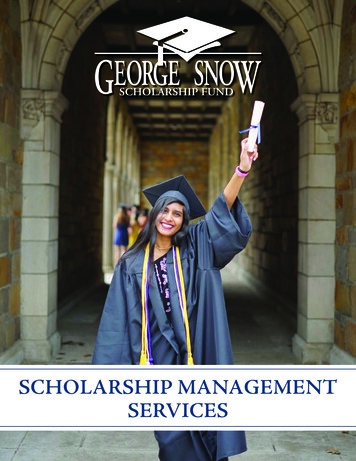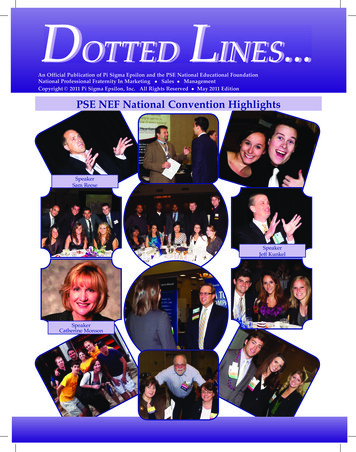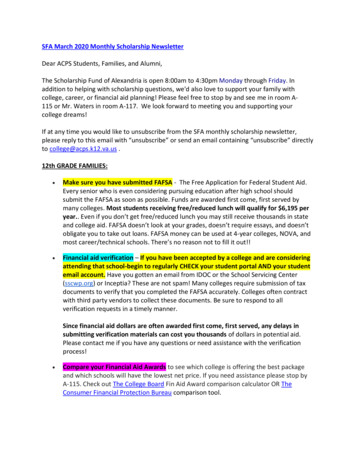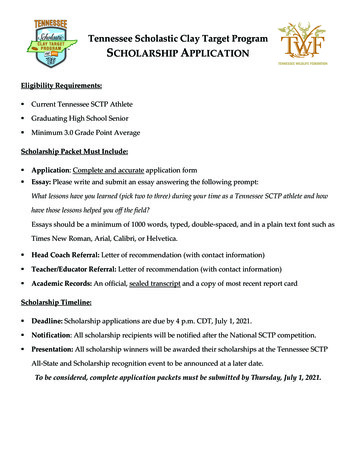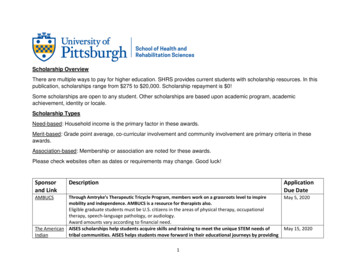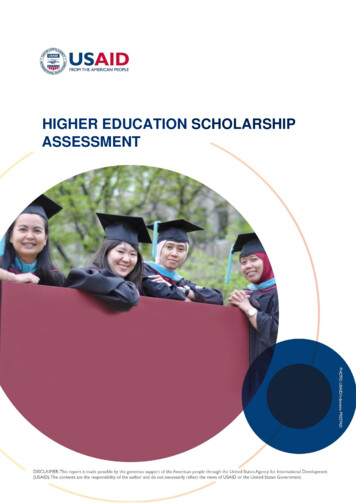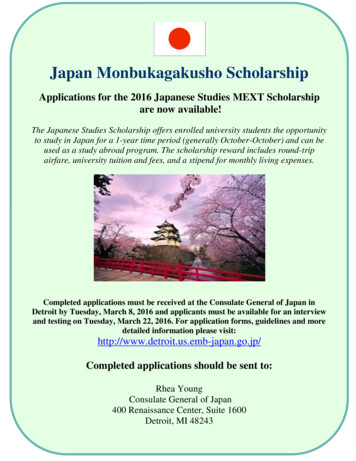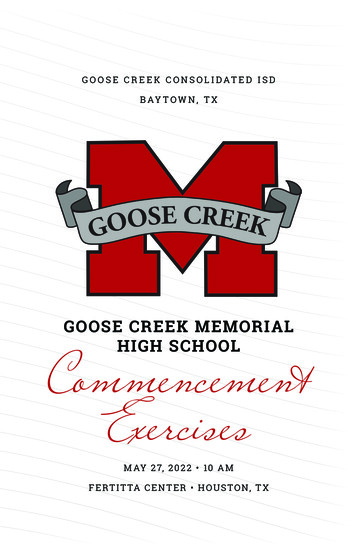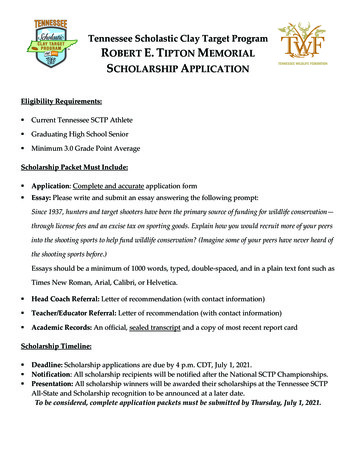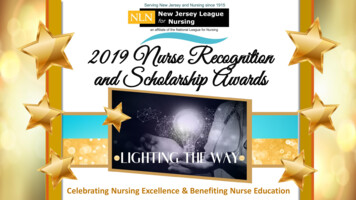
Transcription
JOURNAL FOR ADVANCING SPORT PSYCHOLOGY IN RESEARCH, 2021Vol. 1, Issue 1, 7-21Accentuating Research Scholarship ThroughInnovative Student Opportunities:A Mentored ApproachAmanda J. Visek,1 Thierry R. F. Middleton,2 Liam O’Neil,3Travis R. Scheadler,4 & Monna Arvinen-Barrow5The George Washington University, 2Laurentian University, 3Michigan State University,1The Ohio State University, 5University of Wisconsin – Milwaukee4The Journal for Advancing Sport Psychology in Research (JASPR) accentuates the development of research scholarshipthrough highly immersive, mentored opportunities for students to first author rigorous student-led research and serveas gatekeepers (i.e., as peer-reviewers and editorial board members) of scientific knowledge through an innovativestudent-centered publishing platform. First-author publications are considered one of the foremost pinnacles of scientificachievement for research scholars; and, serving as peer reviewers and Editorial Board members of scientific journalsare, respectively, considered two of the most valued professional service endeavors in the academic realm. JASPR’sstudent-centered operations are intended to enrich students’ knowledge of scientific publishing processes, developand strengthen their scholarship skills, and bolster their abilities and motivation for navigating the complex academicpublishing landscape. As the inaugural editors, in this paper, we: (a) call attention to opportunities in the researchpublishing landscape to involve students through mentored experiences, (b) broadly describe the role of mentorship instudent scholarship, (c) introduce ASPiRE which describes the journal’s mentoring activities and guides the immediate,short-term, and long-term student scholarship impacts in a logic model, and (d) provide an overview of opportunities for,and the benefits of, student involvement in the journal. Finally, we conclude with a call for student and faculty engagementin the journal.Keywords: editorial board, mentoring, peer-review, publishingUnderstanding of the scientific process, theresponsible conduct of research, and disseminationof scientific findings are integral learning outcomesgraduate students are expected to achieve through thecompletion, and publication, of theses and dissertations.Furthermore, for graduate students pursuing positions inacademia, publishing original research in peer-reviewedjournals is an important indicator of promise as an earlycareer scholar (Carpenter, 2008; Cassuto, 1998). In fact,amassed publications are one of the primary barometersby which research productivity is measured (Adams,2003; Riffe, 2005; Wootton, 2013). Publishing, however,is not an easy feat. Submitting authors face a high rateCONTACT: Dr. Amanda J. Visek, The George WashingtonUniversity, Milken Institute School of Public Health,Department of Exercise & Nutrition Sciences, 950 NewHampshire Avenue, NW, Suite 200, Washington, D.C., USA.E-mail: avisek@gwu.eduof rejected manuscripts by peer-reviewed publications(Moizer, 2009; Treviño, 2008). For example, more thanhalf of submitted peer-reviewed research manuscriptsare not accepted for publication (Blümle et al., 2016;Chen et al., 2016; Schumaker et al., 2014). Consequently,graduate students may feel unqualified to attempt topublish their work and perhaps feel deterred by therigorous academic dance of writing, submitting, revising,and resubmitting their work, sometimes time and again,before their manuscript has met the scientific markdeemed acceptable for peer-reviewed publication. Assuch, graduate student work in the form of class-basedresearch projects and theses, unfortunately, largely goesunpublished (Magori, 2019).As challenging as the peer-review publication processis for graduate student authors, and for all scholars forthat matter (see Day, 2011), it is an important cornerstoneof modern-day science. The peer-review process dependson members of the scientific community, in most casesVolume 1, Issue 1 20217
ACCENTUATING RESEARCH SCHOLARSHIP THROUGH INNOVATIVE STUDENT OPPORTUNITIESresearch scholars with topic knowledge or expertiseevidenced by an established record of publication, toserve as professional reviewers of one another’s scientificwork. Peer review, typically, involves a blinded evaluationof a research manuscript assessed for its validity, reliability,and novelty. This process is intended to uphold theintegrity of the scientific community and be a gatekeeperof scientific knowledge, distinguishing quality researchfrom poor research (Holt & Spence, 2012). Interestinglythough, there is a conspicuous absence of educationand established guidance provided to peer reviewers asevaluators of one another’s scientific research (Daniel,1993). Learning how to peer review, instead, is largely atrial-by-error process (Smith, 2006). According to Callahamand Tercier (2007), this can contribute to an unpredictablequality of evaluations conducted by peer reviewers, aswell as variable, and at times, conflicting evaluationsgiven by reviewers assigned to the same manuscript (seeBornmann et al., 2010; Cicchetti, 1991, 1997; Ernst etal., 1993). As a result, “Reviewer 2”’ jokes are commonlymade among submitting authors under the pretensethat Reviewer 2 is assumed to be an exceptionally poorevaluator (see Peterson, 2020). Given the magnitudeof the peer reviewer’s role as a guardian of scholarlyknowledge, the lack of formalized training in peer reviewis a disconcerting aspect of the scientific review process.When graduate students are trained in peer review, itis largely done through faculty mentoring (Smith, 2006).We acknowledge, however, that many students’ graduatetraining may not include peer review. This is likely notthe result of a lack of willingness on the part of faculty,but instead the result of an absence of having receivedformalized training themselves as graduate students,compounded further by limited time and a dearth ofresources to provide such training, even informally, totheir current students. Subsequently, over the years, therehave been numerous calls for the creation of educationalopportunities that engage manuscript reviewers inlearning the nuances of evaluating scientific research(e.g., Cicchetti, 1991; Davidoff, 2004; Mulligan et al., 2012;Smith, 2006). Among them is Brustad, who in 1999 stated:For the betterment of research in sport and exercisepsychology, as well as for the professional developmentof the individual reviewer, I believe that it is essential toprovide our graduate students and young professionalswith opportunities to develop the expertise andmotivation that will make them effective reviewers(pp. 311-312).Scientific publications are indeed a reflection of theauthor(s) work, and also a reflection of the process andrigor, or lack thereof, of peer review.8Journal for Advancing Sport Psychology in ResearchOne approach to becoming an effective manuscriptreviewer is through the creation of formalized,structured opportunities for graduate students toengage in the process of peer review. The opportunityto receive guidance, early on in peer-review endeavors,can better prepare graduate students to conduct higherquality manuscript reviews when invited to serve asprofessionals, which will undoubtedly both inform andstrengthen their own writing as submitting authors ofpeer-reviewed academic manuscripts. Likewise, studentopportunities to serve as editorial board members ofan academic journal can provide a unique opportunityto “pull back the curtain” on the academic publishingprocesses that students and early career professionals areotherwise blind to. Most often, editorial board positionsare bequeathed solely to experienced researchers withhighly successful publication records. This may be one ofacademia’s greatest missed opportunities for graduatestudent training in research scholarship. Perhaps there isno greater way for students to learn and appreciate theins and outs of academic publishing than to be integratedinto the editorial board structure of scientific journalsand engage in experiential learning through mentoredrelationships with reputable faculty researchers servingin editorial board positions.To these ends, the Journal for Advancing SportPsychology in Research (JASPR), the Association forApplied Sport Psychology’s (AASP) newest open-accessscientific publication, seeks to provide students withdidactic authorship, peer and professional manuscriptreview, and editorial board experiences through astructured outlet for rigorous student-led scholarship(see Hess et al., 2021 of this issue). The purposes of thispaper are three-fold: (a) overview the role of mentorshipin accentuating graduate student scholarship, (b)introduce the student-centered mentoring frameworkwe, as the inaugural editors of JASPR, established forencouraging and inspiring the development of students’research scholarship, and (c) provide an overview ofthe journal’s unique and highly immersive academicpublishing opportunities for students. We conclude thepaper with a call for student and faculty involvement inthe journal.Mentorship in Graduate StudentScholarshipMentoring is generally described as a supportiverelationship that helps us learn and develop in ourprofessional, academic, and personal lives (Ragins &Kram, 2007). While there are various types of mentoringthat can take place throughout students’ educational
ACCENTUATING RESEARCH SCHOLARSHIP THROUGH INNOVATIVE STUDENT OPPORTUNITIESexperience, we focus our attention here, broadly, onfaculty-to-student mentoring and student-to-studentpeer mentoring. We also highlight benefits to facultyand student mentors that serve to accentuate researchscholarship.Benefits of Faculty-to-Student MentoringA core component of graduate student educationis faculty-to-student mentoring (Kelly & Schweitzer,1999; Lechuga, 2011; Watson et al., 2009). Most often,graduate students’ formal mentoring will come from afaculty member in their ‘home’ department (Watson etal., 2009) and should expand graduate students’ breadthand depth of knowledge and skills. Additionally, highquality faculty mentoring is likely to benefit studentssocially and emotionally in ways that foster feelings ofconnectedness and satisfaction for them, develop theirability to cultivate stronger interpersonal relationships,and improve their self-regulation skills (Eby et al., 2008;Hamilton et al., 2019; Ramirez, 2002; Taylor & Neimeyer,2009). Further, students benefit psychologically in waysthat accentuate their academic and overall professionaldevelopment, including but not limited to theirdevelopment of self-identity, confidence, autonomy,sense of purpose, ambition, research productivity, andjob search self-efficacy (Eby et al., 2008; Green & Bauer,1995; Hamilton et al., 2019; Ramirez, 2002; Taylor &Neimeyer, 2009; Tenenbaum et al., 2001).As a result, mentoring can be pivotal in positioningthe trajectory of graduate students’ research pursuitsby shaping their identities and initiating the formationand growth of their academic networks. Accordingly,the presence of a positively regarded faculty mentorcan improve students’ reported satisfaction withtheir graduate training (Clark et al., 2000). Further,positively regarded faculty mentors and strong advisingrelationships may be particularly important for retainingwomen in the fields in which they completed theirgraduate study (Ivie et al., 2016). We acknowledge,however, mentored experiences are not necessarilyequally delivered or received. For a myriad of reasons,students may discover themselves needing to identifymentors outside their program of study or academicinstitution and establish mentoring relationships on theirown volition (Watson et al., 2009). For graduate studentsin the field of psychology across the domains of sport,exercise, and performance, JASPR is a unique academicpublishing platform whereby students can receivefaculty-to-student mentoring through their involvementin structured research scholarship opportunities.Benefits of Student-to-Student PeerMentoringThe benefits of student-to-student peer mentoringin academia can include, though are certainly notlimited to: the expansion of students’ critical thinkingand collaboration skills (Dolan & Johnson, 2009;Wong et al., 2016), improved sense of social supportand responsibility (Wong et al., 2016), enhancedpsychological wellbeing (Watson et al., 2009; Wong etal., 2016), greater academic performance and success(Chester et al., 2013; Hryciw et al., 2013; Leidenfrost etal., 2014), as well as heightened persistence and studentenrollment retention (Collings et al., 2014; Crisp, 2010).The aforementioned benefits are important to students’growth as research scholars. Peer activities, such asgraduate student writing groups that allow studentsto connect over shared challenges, can amelioratefeelings of isolation in the writing and publicationprocesses. Activities like these can increase students’self-confidence in their abilities to write with the goalof publishing (Belcher, 2009), while also increasing thenumber of manuscripts they submit to peer-reviewedjournals (Kamler, 2008). Most certainly, the opportunityfor students to share travails and successes with oneanother can help them feel greater relatedness to oneanother and bond over shared interests and pursuits,which are important components of academic learningand growth (see Belcher, 2009; Graham & McClain,2019; Reddick, 2012; Watson et al., 2009).For students from marginalized populations,student-to-student peer mentoring is likely evenmore critical. For example, for Black students enrolledin predominantly White institutions, student-to-studentpeer mentoring has been reported to boost theirsense of belongingness (Graham & McClain, 2019).Connection to, and inclusion of, one another, are at theheart of student-to-student peer mentorship, which isassociated with better academic adjustment and socialintegration (Barnett, 2011; Chester et al., 2013; Collingset al., 2014), as well as decreased feelings of alienation(Graham & McClain, 2019; Levett-Jones et al., 2007;Wong et al., 2016). As a student-centered journal, JASPRrecognizes the important role of peer mentoring andhow students’ connectedness to one another, throughshared experiences, facilitates their mutual growth asresearch scholars. Students that participate in JASPR’smany immersive student opportunities (see latersection of this paper) will reap benefits of receiving bothfaculty-to-student mentorship and student-to-studentpeer mentorship.Volume 1, Issue 1 20219
ACCENTUATING RESEARCH SCHOLARSHIP THROUGH INNOVATIVE STUDENT OPPORTUNITIESReciprocal Mentoring BenefitsAccording to empirical evidence (e.g., Colvin &Ashman, 2010; Dolan & Johnson, 2009; Reddick et al.,2012; Tenenbaum et al., 2001) and scholarly anecdotes(e.g., DuBois et al., 2011; Horowitz & Christopher, 2013;McKinsey, 2016; O’Hara et al., 2019; Ragins & Kram,2007; Rhodes, 2002, 2005) mentoring relationshipsare reciprocally beneficial. Generally, there is greatsatisfaction in being afforded the privilege of, andopportunity to, mentor and “pay forward” knowledge,skills, and lessons learned from one’s own experiencesto positively influence the growth and developmentof the next generation of learners and scholars. Wewould, thus, be remiss not to acknowledge the benefitsof these relationships to faculty and student mentors,particularly with regard to scholarship development andits intersection with JASPR service involvement.Faculty MentorsFor faculty, mentoring activities are highly regardedacross academia’s three treasured pillars: research,teaching, and service. Consequently, developing synergiesacross the three pillars, in creative ways, can generatemore sustainable academic environments (see Boyer etal. 2012 case study example). The volume of studentsmentored by a faculty member and the successes of theirstudents are metrics by which faculty impact is measuredannually through academic performance reviews, andmost certainly through promotion and tenure dossiers(see Burnham et al. 2010, Tools for Dossier Success:A Guide for Promotion and Tenure). JASPR’s studentcentered publishing platform provides a unique, andcreative, opportunity for faculty serving on the EditorialBoard to educate and further the development of studentscholars through the provision of professional service in aresearch publishing infrastructure.Student MentorsSimilarly, for students, peer mentoring activities serveas important, and early, indicators of service stewardship,as well as their ability to lead and teach which enhancescareer readiness (Abbott-Anderson et al., 2016; Horowitz& Christopher, 2013). Graduate students, for example,often enter faculty and other professional positionswith minimal experiences as mentors (and as previouslydiscussed, with minimal experience as peer reviewers),though are expected to be excellent mentors (and peerreviewers) upon entering the academic workforce.However, we believe early opportunities to mentorgraduate students in research scholarship, like thoseafforded to students through their involvement in JASPR,10Journal for Advancing Sport Psychology in Researchcan simultaneously bolster their leadership, advocacy,and networking skills (see Colvin & Ashman, 2010) andtheir teaching and communication skills (see Dolan &Johnson, 2009). These skills serve to prepare students toexcel across all three of academia’s valued pillars (i.e.,research, teaching, and service).Advancing Sport Psychologyin Research:A Student-Centered ApproachIn the same spirit as the JASPR name (Journal forAdvancing Sport Psychology in Research), we assiduouslycurated an Advancing Sport Psychology in Research(ASPiRE) logic model to describe the journal’s uniquestudent-centered publication operation and guide itsintended immediate, short-term, and long-term impactson student scholarship development (see Figure 1).ASPiRE assumes students’ growth and developmentshould be nurtured and supported by faculty and thatstudents are active social agents with an innate desireto grow, master challenges, advance their developmentas scholars through immersive experiences, and broadentheir academic network. Consistent with the missionand vision of JASPR, beyond offering the opportunity forstudents to write, submit, and upon acceptance, publishfirst-author research, the journal offers developmentopportunities for students to engage in the peer-reviewprocess. In addition, alongside faculty serving asmembers of the journal’s Editorial Board (i.e., EditorialBoard Reviewer, Managing Editor, Associate Editor, andEditor-in-Chief), JASPR offers unique opportunities forstudents to serve alongside them in mentored positionsas junior counterparts (i.e., Junior Editorial BoardReviewer, Junior Managing Editor, Junior Associate Editor,and Junior Editor-in-Chief). Mentoring and interactionsamong students and faculty, within these three distinct,yet corollary academic publishing environments (i.e., firstauthor, peer reviewer, junior editorial board member)will be varied in nature and include dynamic practices andstrategies that are both social and non-social in naturerooted in the theoretical principles of self-determination(Deci & Ryan, 1985; Ryan & Deci, 2017) and self-efficacy(Bandura, 1997)– psychological constructs that have,empirically, been found to be integral in fostering humanmotivation and high performance.First, ASPiRE recognizes the manuscript preparationand submission process for student authors asan important environment for mentoring. Withinthis environment, JASPR’s Editorial Board input ispredominantly non-social in nature, where a student
ACCENTUATING RESEARCH SCHOLARSHIP THROUGH INNOVATIVE STUDENT OPPORTUNITIESand the student’s faculty advisor utilize JASPR’spolicies and procedures, educational materials, andchecks and balances to guide the student’s manuscriptpreparation and submission. Second, in the peer-reviewenvironment, a range of faculty-to-student and studentto-student peer-mentoring occurs both betweenJASPR Editorial Board faculty and students, as well asbetween student peer reviewers and JASPR EditorialBoard members. Each plays a crucial part in gatekeepingscientific knowledge through mentorship and successfulscholarship development of the students involved inthe process. The peer-review environment includessocial and non-social strategies and practices to ensurestudents learn the ins and outs of quality peer-review.For example, in addition to required online peer-reviewtraining modules, JASPR offers student-centeredresources including a Reviewer Handbook to helpfacilitate manuscript reviews. Additionally, student peerreviewers have the opportunity to seek further guidancefrom JASPR Editorial Board members (e.g., AssociateEditor, Junior Associate Editor), who can provide supportas they navigate and learn the peer-review process.Third, and lastly, service to the profession by way ofmembership on the JASPR Editorial Board provides anenvironment where varied opportunities for facultyto-student mentoring and student-to-student peermentoring are afforded to students. Special emphasisis placed on ensuring effective role clarity, verbal andwritten communication, social support, and creatingopportunities for self-reflection, self-monitoring, andself-advocacy, to name a few (see again Figure 1).In these three publishing environments, we anticipatethe dynamic interaction between students and faculty,using varied social and non-social mentoring practicesand strategies, will result in enhanced psychosocialoutputs including increased knowledge of publishingprocesses from important publishing vantage points(i.e., as the first author of a manuscript submitted forpeer review, as a peer reviewer of scientific manuscripts,and as an editorial board member tasked with ensuringthat published work is of high quality to advance thefield of psychology in the domains of sport, exercise, andperformance). Further beneficial outputs for studentsactive in the publication process are discussed in thesections below. Our hypothesis is that these specificoutputs will lead to more general outputs of increasedscholarly self-efficacy and feelings of competence,autonomy, and relatedness which will facilitate thegrowth and development of students as self-confidentand autonomously motivated student scholars.Immersive Student Opportunities:Author & ReviewerBenjamin Franklin is famously quoted as saying, “Tellme and I forget. Teach me and I remember. Involveme and I learn.” Immersive experiences imply a socialFigure 1. Advancing Sport Psychology in Research (ASPiRE) Logic ModelJASPR Vision & Mission:Student-Centered Publication Environment Student submitting author Faculty advisor Co-authorsFirstAuthorPeerReview Student submitting author Faculty advisor/co-authors Invited peer reviewers Invited professional reviewers Editorial Board membersEditorial Board Students: Jr Editor-in-Chief, JrAssociate Editors, Jr Editorial BoardReviewers, Junior Managing Editor Faculty: Editor-in-Chief, AssociateEditor, Managing Editor, EditorialBoard Reviewer(s)AssumptionsInputs:JASPR Mentoring Practices & come Role clarity Social support (faculty-to-student and student-tostudent peer guidance and mentoring) Effective verbal and written communicationKnowledge ofpublishingprocesses Autonomy and competence facilitating feedback(written and/or verbal)Writingdevelopment Transparent policies and procedures (i.e.,submission guidelines, CRediT statement, peerreview guidelines, peer-review process)First-authorsubmission Educational materials (i.e., instructional videos,supplementary URL links) Checks and balances for actionable steps (i.e.,submission and reviewer checklists) Mastery experiences throughout the submissionand peer-review process Opportunities for self-reflection, self-monitoring,and self-advocacy throughout the submission andpeer-review processExternal FactorsCompletedpeer review utonomouslymotivatedstudentscholarNetworking &relationshipbuildingImmediate, Short-term, & Long-term ImpactVolume 1, Issue 1 202111
ACCENTUATING RESEARCH SCHOLARSHIP THROUGH INNOVATIVE STUDENT OPPORTUNITIEScontext in which connections are developed with othersthrough mentored teaching and learning. Specifically,we aim to promote a collective student-centered effortthat brings forward creative rigorous scholarship fromstrategically conceived, highly immersive, didacticteaching and learning opportunities for students toengage in all aspects of the publication process. In thefollowing sections we provide an overview of the arrayof opportunities for student involvement in the journal.For each, prerequisite qualifications are provided,followed by a description of a role’s opportunities andresponsibilities, along with a summary of the benefitsafforded to students from the experience.Submitting AuthorConsistent with JASPR’s vision, mission, and scope,the expectation is the submitting author has conductedrigorous student-led research and is a student at the timeof manuscript submission or is within the first two yearsfollowing the completion of requirements for a master’sor doctoral degree from an accredited institution.Role and ResponsibilitiesThe submitting author’s role is that of the leadand corresponding author. Responsibility rests withthem to prepare a manuscript in accordance with thesubmission guidelines set forth by the journal. Theseinclude, for example: adherence to ethical standards,use of bias free language, adoption of the journal’srequired font style and size in writing the manuscript,adherence to the APA Style Publication Manualwith respect to formatting professional papers andin-text reference citations and the reference list. Thesubmitting author is also responsible for completing andsubmitting supporting documents that must accompanythe manuscript including a cover letter, CRediT rolestatement that identifies author contributions to themanuscript, and submission checklist. Unique to JASPR,all authors must also complete a JASPR SubmissionChecklist to ensure they have complied with requiredmanuscript elements, provided responsible conduct ofresearch assurances, specified conflict of interest andauthor contribution transparency, and delineated authorcontact information for all future correspondenceregarding the manuscript. Much of this informationis typically provided in a cover letter (also required);however, the JASPR Submission Checklist was createdas a supplementary requirement to authors as ameasure of structured checks and balances to ensure athorough and complete submission, thereby increasingstudents’ competence and self-efficacy as a lead andcorresponding author. To assist submitting authors in12Journal for Advancing Sport Psychology in Researchpreparing their manuscript for submission, authors haveaccess to an Author Handbook that provides detailedguidance for navigating manuscript preparation and theunique requirements of JASPR’s submission process.Opportunity BenefitsAn obvious benefit to submitting authors is theopportunity for graduate students to first author theirwork and have it considered for publication. First-authorpublications are among the most highly valued and areincredibly important entries on the curriculum vitae(CV) of graduate students pursuing careers in academia.Generally, authors are listed in order of relativecontribution. In psychological science, according tothe APA Style Publication Manual, the first authorhas contributed the most, including the writing of themanuscript (for a fuller understanding of instancesin which the lead and senior authors toggle betweenfirst and last in authorship order, and how this can varyacross scientific disciplines, see Arvinen-Barrow & Visek,2021 of this issue). As with any peer-reviewed journal,publication in JASPR is not guaranteed and is contingentupon the evaluation outcomes of external doubleblinded peer reviews, as well as those by other facultyand student members of the Editorial Board.That said, regardless of whether a manuscript isaccepted for publication, of great benefit to submittingauthors are the learning outcomes that occur as a processof “doing” on the pre-submission front end of the guidedauthorship experience (i.e., writing the manuscript,preparing all ancillary submission documents thataccompany the manuscript, communicating with coauthors), submission of the manuscript (see Figure 2which outlines JASPR’s workflow managementprocesses for each submitted manuscript), and thepost-submission backend of the peer review process(i.e., receiving the manuscript decision of reject, reviseand resubmit, or accept; reflecting on the peer-reviewfeedback; and most often, working with co-authorsof the manuscript to improve the presentation ofthe manuscript for resubmission or submission to analternative journal). The opportunity to first author aresearch publication is intended to foster an author’sself efficacy and competence in navigating publishingprocesses, so they are more confident in their abilitiesand autonomous in their future research endeavors andmanuscript submission efforts. Additionally, authors willhave direct correspondence with, and the opportunityto seek guidance from, student and faculty membersof the Editorial Board as they navigate the submissionand publication process. As a result, students may feel
ACCENTUATING RESEARCH SCHOLARSHIP THROUGH INNOVATIVE STUDENT OPPORTUNITIESFigure 2. JASPR’s Workflow Management Processes for Each Submitted ManuscriptManuscript submitted to JASPRREJECTManuscript rejectedIntake review conductedJunior Editor-in-Chief/Editor-in-ChiefManuscript forwarded for peer reviewJunior Editor-in-Chief/Editor-in-ChiefJunior Associate Editor assigned to manuscriptAssociate EditorPeer reviewer recommendations rejectedAssociate EditorPeer reviewers selectedJunior Associate EditorPeer r
Volume 1, Issue 1 2021 7 Accentuating Research Scholarship Through Innovative Student Opportunities: A Mentored Approach Amanda J. Visek,1 Thierry R. F. Middleton,2 Liam O'Neil,3 Travis R. Scheadler,4 & Monna Arvinen-Barrow5 1The George Washington University, 2Laurentian University, 3Michigan State University, 4The Ohio State University, 5University of Wisconsin - Milwaukee
